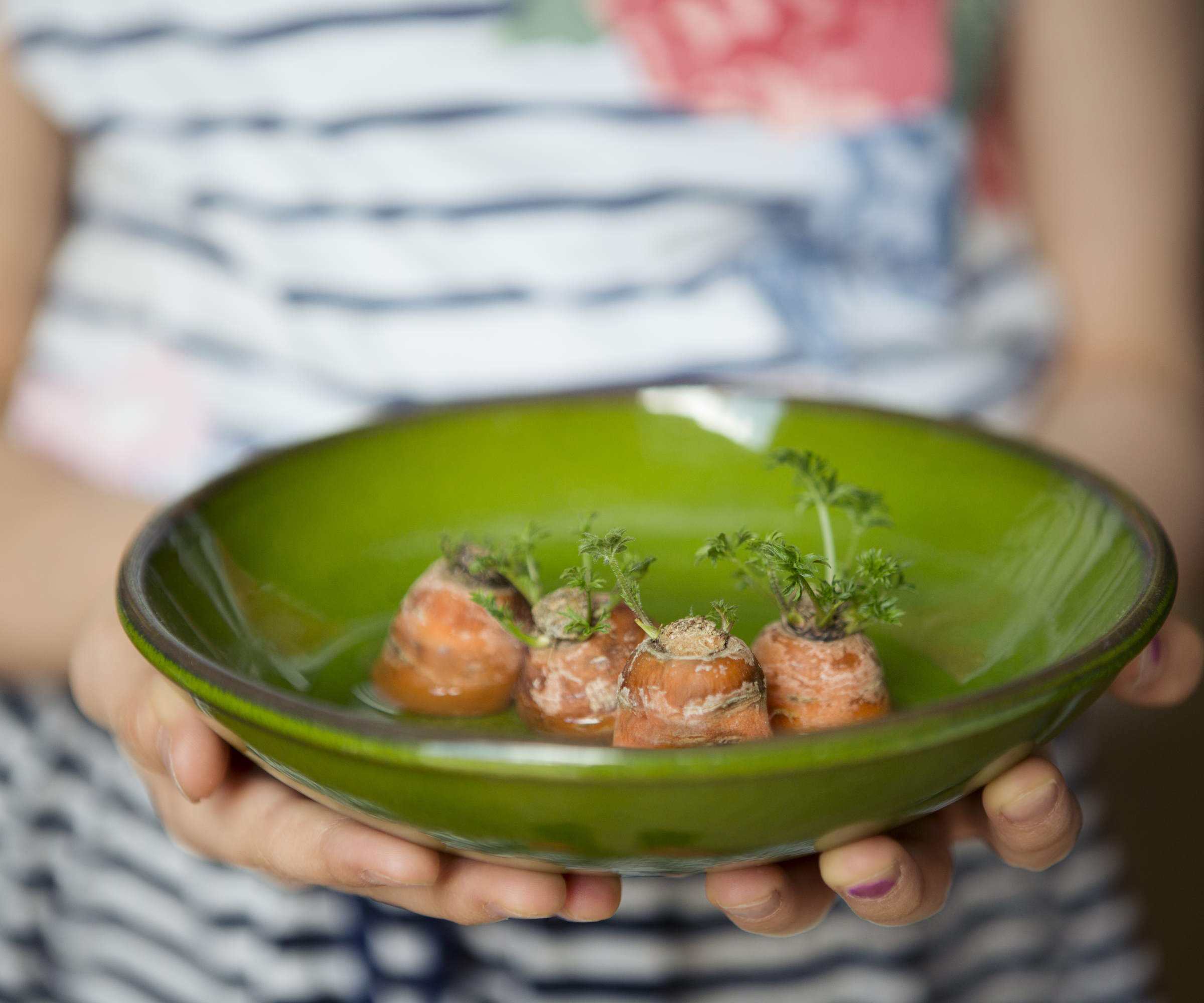How to grow carrots from carrot tops – a simple and fun way to regrow from scraps
You won’t get a new carrot, but you will get a crop of tasty carrot greens - and even carrot seeds to sow


If you grow your own carrots at home, are you also growing carrots from carrot tops? This concept of regrowing crops from scraps is easy and quick, and means you can get a sometimes second crop from your plants.
You cannot grow another carrot from the carrot top, however. Instead, you grow carrot greens. The leafy foliage that sprouts is edible, has a strong taste similar to parsley, and can be eaten raw or cooked.
If you continue growing the carrot plant until it flowers and sets seeds, you can potentially sow these again next spring as part of your vegetable garden ideas. We take a look at how to do it.

Carrot tops can be quickly sprouted in water
Why grow carrots from carrot tops?
Growing carrots from carrot tops is a fantastic project for the family, as well as being a sustainable way to grow edible crops from material that would otherwise just get thrown into the trash.
It is a simple activity to get kids interested in learning about growing plants, too, and requires only a few supplies to complete.
How do you grow carrots from carrot tops?

Growing carrots from carrot tops is a fun project for the family
It is a very simple process to grow carrots from carrot tops and only requires a handful of common household items. You can use carrots you have grown in your kitchen garden or carrots bought from farmers markets or grocery stores. The most important thing is that the carrots you use still have their tops attached. This is a great way to grow carrots indoors.
Jessica Mercer from Plant Addicts recommends six simple steps to follow at home if you want to resprout carrot tops:
Design expertise in your inbox – from inspiring decorating ideas and beautiful celebrity homes to practical gardening advice and shopping round-ups.
- Select a carrot with greens at the top
- Cut off the carrot top about an inch down from where the greens start
- Snip off all but the lower inch of the greens
- Place the carrot top in a shallow dish with about a half inch of water
- Set the dish in a sunny window, away from cold drafts and heating vents
- Change the water in the dish every few days, and make sure it doesn't all evaporate and dry out the cutting
New green shoots can start to appear from the top of the cutting in as little as three days, followed by small hair-like roots emerging from the sides of the remaining section of the tap root.
‘After a few weeks of the carrot top developing new shoots and roots, they can be transplanted into a container. When choosing a soil, ensure that it is a well-draining soil mix, like Miracle-Gro Potting Mix,’ says Amy Enfield, senior horticulturist at ScottsMiraclo-Gro.
‘When planting your carrot top, be sure to keep the crown, also referred to as the 'shoulders’, of the remaining tap root just above the soil surface.’
Place the container somewhere warm and bright, such as a sunny windowsill, and the soil should be kept consistently moist, but not allowed to sit too soggy. Though not essential for healthy growth, a water-soluble balanced fertilizer can be diluted to half strength and applied once a month.
The edible carrot greens can be harvested as-and-when required, starting a few weeks after the cutting has been planted into the container.

A recommended potting mix for planting sprouted carrot tops. This potting mix has added fertilizer that feeds plants for up to six months

Jessica Mercer is the Senior Content Marketing Coordinator for Plant Addicts. As a plant collector, Jessica enjoys growing many different plants and learning about the best culture practices for each. She uses her science background to research interesting plant topics and present the information to other gardeners for Plant Addicts.

Amy Enfield has over 25 years of experience in the Lawn & Garden industry and has been with ScottsMiracle-Gro for 11 years. She has a BS and MS in Horticulture from Michigan State University and a PhD in Plant & Environmental Sciences from Clemson University.
Can I grow a carrot from a carrot top?

Sprouted carrot tops planted into soil will not grow into a new carrot
The taproot of a carrot will not regrow once it is cut off - another carrot will not grow by planting a sprouted carrot top.
Josh Tesolin, co-founder of RusticWise, claims, however, that there is a way to grow a new carrot taproot from a carrot top, but ‘you'll need to be patient’.
‘Carrots are biennial, which means they go to seed in their second year,’ he says. ‘Once the tops have flowered, then turned brown, you can collect the tiny seeds. Let the seeds dry and store them in a cool, dry location and sow them the following year in early spring.’
Snip off the carrot’s flower head and collect seeds by shaking them into a paper bag. Store the seeds in a cool and dry place, to ensure their integrity for sowing next year, and the carrot will die back after it has set seed.
If you do intend to grow the carrot top to collect the seed, then it is advisable to grow an heirloom type rather than hybrid or F1 seeds. Use carrots you grew organically from your garden or purchased from a farmers market, rather than carrots from a grocery store, as you will not know the heritage of the carrots you are buying.
FAQs
Can you plant a whole carrot?
If you plant an entire carrot into the soil and give it the right amount of sun, light, and water, then it will start to flower and go to seed. You would be able to collect and store the seeds, ready to sow these new free seeds the next spring.
As well as growing carrots from carrot tops, there are other vegetables you can regrow from scraps. It includes growing onions from scraps, growing lettuce from scraps, and growing celery from a stalk - they are all simple projects that can reward you with fresh harvests in a sustainable way.

Drew has worked as a writer since 2008 and was also a professional gardener for many years. As a trained horticulturist, he worked in prestigious historic gardens, including Hanbury Hall and the world-famous Hidcote Manor Garden. He also spent time as a specialist kitchen gardener at Soho Farmhouse and Netherby Hall, where he grew vegetables, fruit, herbs, and cut flowers for restaurants. Drew has written for numerous print and online publications and is an allotment holder and garden blogger. He is shortlisted for the Digital Gardening Writer of the Year at the 2025 Garden Media Guild Awards.